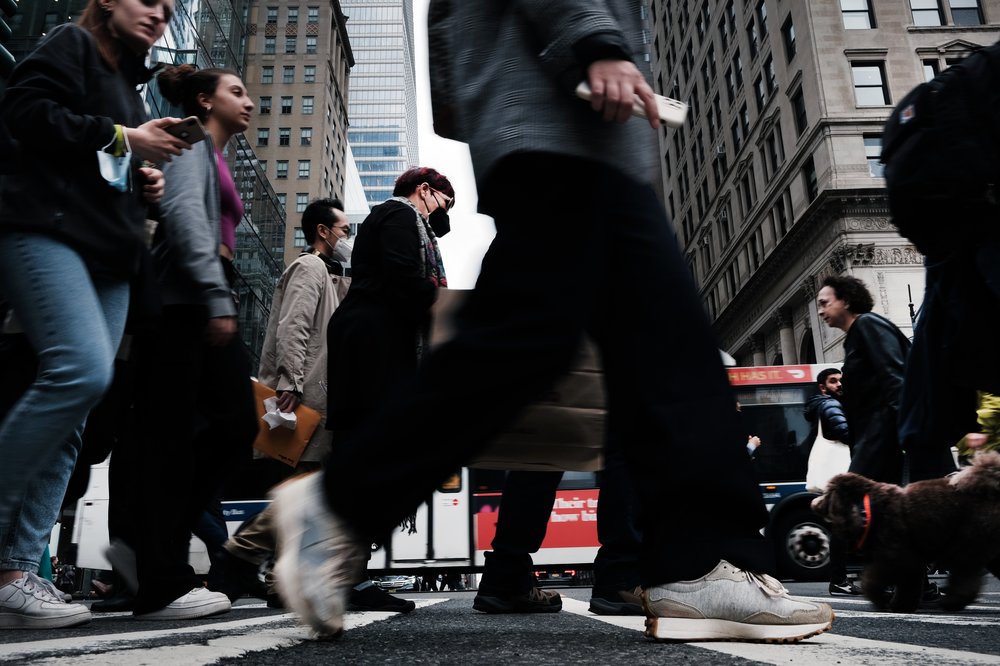Vehicle traffic is down in Manhattan, but pedestrian traffic is up, data says
Feb. 13, 2025, 6:31 a.m.
Congestion-pricing has eased traffic in Manhattan, but it hasn't kept pedestrians away.

The worry that congestion pricing would turn prime Manhattan business districts into dead zones is belied by new economic data showing pedestrian traffic is up in the borough, including in the “congestion zone” below 60th Street.
Overall pedestrian traffic in Manhattan was up 4.6% between the Jan. 5 start of congestion pricing and Jan. 31, compared to the same period last year, according to the city’s Economic Development Corporation. Some 35.8 million people entered business improvement districts in the congestion zone, the area south of 60th Street where drivers have to pay $9 to enter during peak hours, it said.
That was 1.5 million more people than during the same period in 2024, according to the findings, which were first reported by Crain’s New York Business, and follows disclosures by the MTA that 7% fewer cars entered the zone in the first weeks after congestion pricing came into effect.
"Congestion pricing is working,” said Ben Furnas, the executive director of the advocacy group Transportation Alternatives. “Fewer cars are traveling into the Congestion Relief Zone, all while more people are visiting Manhattan to shop and catch a show on Broadway.”
Kate Slevin, the executive vice president of the Regional Plan Association, a nonprofit that serves the tristate area, said the data on pedestrian traffic suggests that despite “a lot of concern” over congestion pricing, “it's clear the sky has not fallen.”
She added: “The first month-plus has been a total success.”
The largest increases in foot traffic were in commercial areas within the Congestion Relief Zone, according to the Economic Development Corporation. These include SoHo, Times Square, Fifth Avenue, 34th Street and the West Village, which all experienced at least 8% spikes in pedestrian activity in January when compared to the same period in 2024.
The analysis relied on data from Placer.ai, which measures foot traffic using pedestrians’ cellphone location data.
"The data showing the increase in foot traffic is confirmation that the program is working and will not deter people from the Central Business District. It illustrates that more people are taking public transit to get to the city center," said Kevin Garcia, senior transportation planner at the New York City Environmental Justice Alliance. "We hope that we see similar foot traffic increases in the other boroughs and improvements in air quality."
Despite the growth in pedestrian traffic, business groups said many local businesses remain ambivalent about the changes, with some businesses citing higher costs for deliveries as a result of congestion pricing as well as customers frustrated by the fee to drive into the zone.
The signs of rising foot traffic came despite a polar vortex that has sent temperatures plunging this year. Although companies nationwide have been issuing return-to-office mandates, the harsh winter weather resulted in 5% fewer office visits in New York this January compared to January a year ago, according to Placer.ai. Still, New York leads the nation’s return-to-office phenomenon, according to the company’s analysis.
In some areas below 60th Street, the increase in pedestrian traffic was especially pronounced.
Foot traffic at the intersection of Broadway and Prince Street in SoHo spiked by 20% year-over-year since the introduction of congestion pricing, said Erin Piscopink, the executive director of the SoHo Broadway Initiative, a business improvement district that represents 150 businesses.
The Grand Central Partnership said pedestrian traffic rose 18.5% in its district in Midtown, which comprises more than 750 ground-floor businesses, including Grand Central Oyster Bar, Paul Stuart and the NBA Store.
Ryan Pukos, the partnership's director of data, said by contrast, pedestrian traffic in January 2024 rose by just 5% compared to January 2023.
Zach Owens, the executive director of West Village Business Improvement District, said foot traffic was up 13% in the district, situated between Hudson Street and Sixth Avenue.
“We’ll continue monitoring trends, but so far, we’re seeing a strong and steady flow of visitors, which is encouraging for our local businesses,” said Owens.
Foot traffic had gone up 7% in the Times Square area bordered by West 40th and 50th streets and Eighth and Sixth avenues, according to Times Square Alliance spokesperson TJ Witham.
Despite the growth, Witham said businesses and other stakeholders “are very evenly split” on the merits of congestion pricing. He said the survey included questions on whether congestion pricing would affect employee retention, improve traffic, speed up deliveries or hurt businesses by increasing delivery costs.
Jeremy Marrin, the CEO of Havana Central restaurant on West 46th Street, said congestion pricing was simply the latest in a series of hurdles faced by restaurants and that it had added to costs, with vendors tacking on $4 to $10 on each delivery.
“ New York restaurants generally have very little storage space,” Marrin said. “So they have to get multiple deliveries from each vendor every week. And it adds up very quickly.”
He added that customers had regularly complained about paying extra to enter the Congestion Relief Zone.
“It just makes it harder for people to come into Midtown,” he said. “So where I think a lot of businesses are trying to bring people back, our lunch business is just dreadful.”
Trump hasn’t 'TERMINATED' congestion pricing in NYC ... yet. Which drivers get tolled under congestion pricing on the Brooklyn and Queensboro bridges? It’s complicated. Judge calls Manhattan traffic 'terrible,' allows congestion pricing lawsuits to proceed Thanks, office workers: Foot traffic in Manhattan nears pre-COVID levels, report says